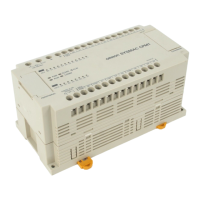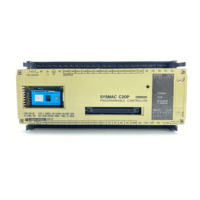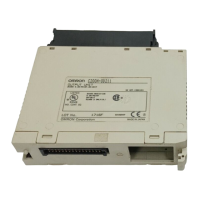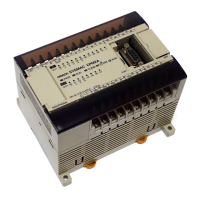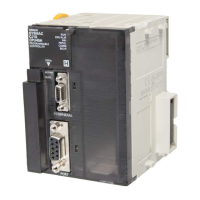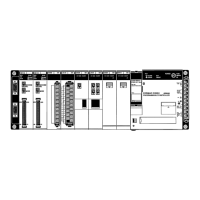421
Control Data The control words, beginning with C, specify the number of bytes of control data
to be sent, the number of bytes of response data to be received, the destination
node, and other parameters. Some control data parameters depend on whether
a transmission is being received in a SYSMAC NET Link System or a SYSMAC
LINK System.
Word Bits 00 to 07 Bits 08 to 15
C Number of bytes to send (0 to 1990, i.e., $0000 to $07C6)
1
C+1 Number of bytes to receive (0 to 1990, i.e., $0000 to $07C6)
1
C+2 Destination network address
(0 to 127, i.e., $00 to $7F)
2
Bits 08 to 11: ($0 to $F)
3
Bits 12 to 15: Set to 0.
C+3 Destination unit address
4
Destination node number
5
C+4 Bits 00 to 03:
No. of retries (0 to 15 in
hexadecimal,
i.e., $0 to $F)
Bits 04 to 07:
Set to 0.
Bits 08 to 11:
Transmission port number
($0 to $7)
Bit 12 to 14:
Set to 0.
Bit 15: ON: No response.
OFF: Response returned.
C+5 Response monitoring time ( $0001 to $FFFF = 0.1 to 6553.5 seconds)
6
Note 1. Maximum number of bytes that can be sent or received:
System Max. number of bytes
SYSMAC NET Link $07C6 (1990)
SYSMAC LINK $021E (542)
SYSMAC BUS/2 $021E (542)
2. Set the destination network address to $00 when transmitting within the
same network.
3. The BASIC Unit interrupt number when a BASIC Unit is designated.
4. Indicates a Unit as shown in the following table.
Unit Setting
PC $00
SYSMAC NET Link or SYSMAC LINK
Unit
$10 to $1F: Unit numbers 0 to F
$FE: The local Unit
SYSMAC BUS/2 Master, BASIC Unit,
or Personal Computer Unit
$10 to $1F: Unit numbers 0 to F
SYSMAC BUS/2 Group 2 Slave $90 to $CF:
Unit number+90+10×Master
address
5. The destination node number can have the following values:
System/type of transmission Possible values
SYSMAC NET Link System $01 to $7E (nodes 1 to 126)
SYSMAC LINK System $01 to $3E (nodes 1 to 62)
Broadcast to all nodes in network $FF
Transmit within the PC
(to/from CPU Bus Units)
$00
6. Designates the length of time that the PC retries transmission when bit 15 of
C+3 is OFF and no response is received. The default value is $0000, which
indicates 2 seconds.
7. Transmissions cannot be sent to the PC executing CMND(194) (i.e., the
Unit cannot be specified as $00 and the destination node number set to
$00).
Precautions C through C+5 must be within the values specified below. To be able use of
CMND(194), the PC must have a SYSMAC NET Link, SYSMAC LINK Unit, or
SYSMAC BUS/2 Remote I/O Master Unit mounted.
Network Instructions Section 5-36
